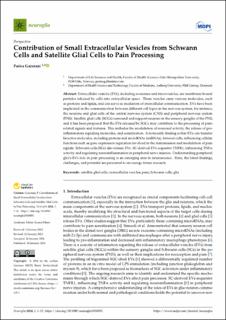Contribution of Small Extracellular Vesicles from Schwann Cells and Satellite Glial Cells to Pain Processing
Peer reviewed, Journal article
Published version
Permanent lenke
https://hdl.handle.net/11250/3114180Utgivelsesdato
2024Metadata
Vis full innførselSamlinger
Sammendrag
Extracellular vesicles (EVs), including exosomes and microvesicles, are membrane-bound
particles released by cells into extracellular space. These vesicles carry various molecules, such
as proteins and lipids, and can serve as mediators of intercellular communication. EVs have been
implicated in the communication between different cell types in the nervous system, for instance,
the neurons and glial cells of the central nervous system (CNS) and peripheral nervous system
(PNS). Satellite glial cells (SGCs) surround and support neurons in the sensory ganglia of the PNS,
and it has been proposed that the EVs released by SGCs may contribute to the processing of pain-
related signals and features. This includes the modulation of neuronal activity, the release of pro-
inflammatory signaling molecules, and sensitization. A noticeable finding is that EVs can transfer
bioactive molecules, including proteins and microRNAs (miRNAs), between cells, influencing cellular
functions such as gene expression regulation involved in the transmission and modulation of pain
signals. Schwann cells (SCs) also release EVs. SC-derived EVs sequester TNFR1, influencing TNFα
activity and regulating neuroinflammation in peripheral nerve injuries. Understanding peripheral
glia’s EVs role in pain processing is an emerging area in neuroscience. Here, the latest findings,
challenges, and potential are presented to encourage future research.

